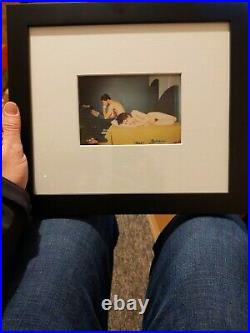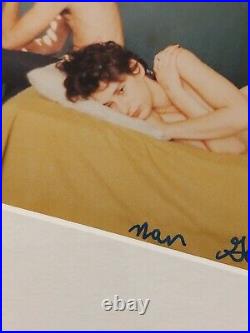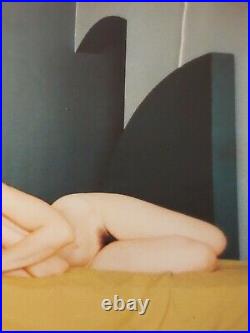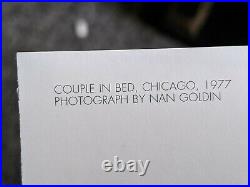NAN GOLDIN Couple in Bed, Chicago 1977 SIGNED FRAMED RARE













Fine art postcard hand signed in black marker pen by Nan Goldin. Sheet size 15 x 10.5 cm.
Frame approximately 34 x 30 cm. Couple in Bed, Chicago, from the series The Ballad of Sexual Dependency, 1977.
Square wooden frame with diagonal cut mount and archive glass. Comprising almost 700 snapshot-like portraits sequenced against an evocative music soundtrack, Nan Goldins The Ballad of Sexual Dependency is a deeply personal narrative, formed out of the artists own experiences around Boston, New York, Berlin, and elsewhere in the late 1970s, 1980s, and beyond.
Titled after a song in Bertolt Brecht and Kurt Weills The Threepenny Opera, Goldins Ballad is itself a kind of downtown opera; its protagonistsincluding the artist herselfare captured in intimate moments of love and loss. They experience ecstasy and pain through sex and drug use; they revel at dance clubs and bond with their children at home; and they suffer from domestic violence and the ravages of AIDS. The Ballad of Sexual Dependency is the diary I let people read, Goldin wrote. The diary is my form of control over my life.
It allows me to obsessively record every detail. It enables me to remember. The Ballad developed through multiple improvised live performances, for which Goldin ran through the slides by hand and friends helped prepare the soundtrackfrom Maria Callas to The Velvet Undergroundfor an audience not unlike the subjects of the pictures. The Ballad is presented in its original 35mm format, along with photographs that also appear as images in the slide show. Introducing the installation is a selection of materials from the artists archive, including posters and flyers announcing early iterations of The Ballad.
Nancy "Nan" Goldin (born September 12, 1953) is an American photographer. Her work often explores LGBT bodies, moments of intimacy, the HIV crisis, and the opioid epidemic. Her most notable work is The Ballad of Sexual Dependency (1986), which documents the post-Stonewall gay subculture and Goldin's family and friends. She lives and works in New York City, Berlin, and Paris.
Goldin was born in Washington, D. In 1953 and grew up in the Boston suburb of Lexington to middle-class Jewish parents. Goldin's father worked in broadcasting and served as the chief economist for the Federal Communications Commission.
Goldin had early exposure to tense family relationships, sexuality, and suicide, as her parents often argued about Goldin's older sister Barbara who ultimately committed suicide when Goldin was 11. This was in 1965, when teenage suicide was a taboo subject. I was very close to my sister and aware of some of the forces that led her to choose suicide. I saw the role that her sexuality and its repression played in her destruction.Because of the times, the early sixties, women who were angry and sexual were frightening, outside the range of acceptable behavior, beyond control. By the time she was eighteen, she saw that her only way to get out was to lie down on the tracks of the commuter train outside of Washington, D. It was an act of immense will. Goldin began to smoke marijuana and date an older man, and by age 1314, she left home and enrolled at the Satya Community School in Lincoln.
A Satya staff member (experimental philosopher Rollo May's daughter) introduced Goldin to the camera in 1968 when she was fifteen years old. Still struggling from her sister's death, Goldin used the camera and photography to cherish her relationships with those she photographed. She also found the camera as a useful political tool, to inform the public about important issues silenced in America.Her early influences included Andy Warhol's early films, Federico Fellini, Jack Smith, French and Italian Vogue, Guy Bourdin and Helmut Newton. Both Goldin and Diane Arbus celebrate those who live marginal lives. Stills from Variety are compared to Arbus' magazine work; the Variety series portray "the rich collision of music, club life, and art production of the Lower East Side pre and post AIDS period". Both artists ask to reexamine artists' intentionality.
One of the reasons Goldin began photographing was Michelangelo Antonioni's Blow Up (1966). The sexuality and glamour of the film exerted a "huge effect" on her.Referring to images shown in Ballad, the beaten down and beaten up personages, with their gritty, disheveled miens, which populate these early pictures, often photographed in the dark and dank, ramshackle interiors, relate physically and emotionally to the alienated and marginal character types that attracted Antonioni. The youths in Larry Clark's Tulsa (1971) presented a striking contrast to any wholesome, down-home stereotype of the heartland that captured the collective American imagination.
He turned the camera on himself and his lowlife amphetamine-shooting board of hanger-ons. Goldin would adopt Clark's approach to image-making. Please look at my other items including rare modern and contemporary art and design pieces. The item "NAN GOLDIN Couple in Bed, Chicago 1977 SIGNED FRAMED RARE" is in sale since Friday, December 4, 2020.
This item is in the category "Art\Art Photographs". The seller is "ashbinx74" and is located in Bruton. This item can be shipped to United Kingdom, Austria, Belgium, Bulgaria, Croatia, Cyprus, Czech republic, Denmark, Estonia, Finland, France, Germany, Greece, Hungary, Ireland, Italy, Latvia, Lithuania, Luxembourg, Malta, Netherlands, Poland, Portugal, Romania, Slovakia, Slovenia, Spain, Sweden, Australia, United States, Bahrain, Canada, Japan, New Zealand, Israel, Hong Kong, Norway, Indonesia, Malaysia, Mexico, Singapore, South Korea, Switzerland, Taiwan, Bangladesh, Bermuda, Bolivia, Barbados, Brunei darussalam, Cayman islands, Ecuador, Egypt, Guernsey, Gibraltar, Guadeloupe, French guiana, Iceland, Jersey, Jordan, Cambodia, Liechtenstein, Sri lanka, Macao, Monaco, Maldives, Martinique, Nicaragua, Oman, Pakistan, Peru, Paraguay, Reunion, Saudi arabia, South africa, United arab emirates, Ukraine, Chile, Bahamas, Colombia, Costa rica, Guatemala, Honduras, Jamaica, Kuwait, Panama, Qatar, Trinidad and tobago, Uruguay, Viet nam.
- Size: Mini (up to 6in.
)
- Artist: Nan Goldin
- Colour: Multi-Colour
- Style: Contemporary Art
- Listed By: Dealer or Reseller
- Features: Framed
- Subject: Love
- Colour Type: Colour
